Homework assignments (4,5 credits) in Computational Physics
Homework assignments (4,5 credits) in Computational Physics
Homework assignments (4,5 credits) in Computational Physics
You also want an ePaper? Increase the reach of your titles
YUMPU automatically turns print PDFs into web optimized ePapers that Google loves.
the heat capacity obta<strong>in</strong>ed from temperature fluctuations <strong>in</strong> a micro canonical (NVE)<br />
simulation and with experimental heat capacities. You may use the MD-program from,<br />
the argon computer lab as a template and make the changes there. (Reference, Frenkel<br />
& Smit p. 125-141.)<br />
4 Monte Carlo studies of simple <strong>in</strong>tegrals<br />
Instructors: Mats Wall<strong>in</strong> or Olle Edholm<br />
S<strong>in</strong>ce this problem is more elementary than the rest, the requirement on the report<br />
is higher <strong>in</strong> order to get grade higher than 3.<br />
Study various simulation methods for the simple test <strong>in</strong>tegral<br />
∫ ∞<br />
0<br />
∫ ∞<br />
0<br />
dx xe −x2<br />
dx e −x2<br />
Evaluate <strong>in</strong> four different ways: (1) Us<strong>in</strong>g a Metropolis method. (2) Simple Monte Carlo.<br />
(3) Simpson’s rule. (4) Exactly us<strong>in</strong>g analytic <strong>in</strong>tegration. In (1), experiment with the<br />
maximum step size δ. Beg<strong>in</strong> with δ = 1, then compare with δ = 0.1 and δ = 10.<br />
Study the statistical error <strong>in</strong> the MC methods by tak<strong>in</strong>g the average RMS error (error<br />
=result from (1) m<strong>in</strong>us result from (4)) as a function of the number of terms N (for<br />
example, N = 10, 100, 1000, 10000, ...) <strong>in</strong> the MC calculation. Is this a good measure of<br />
the statistical error <strong>in</strong> (1) and <strong>in</strong> (2) Why or why not Study the correlation time τ <strong>in</strong><br />
(1). In (1), it is necessary to repeat the calculation many times, and calculate the RMS<br />
errors from the results of these <strong>in</strong>dependent runs. Plot the RMS error vs. N <strong>in</strong> log-log<br />
plots. Compare the cpu times for (1)-(3) to reach a certa<strong>in</strong> error level. Also study the<br />
the more complicated oscillatory <strong>in</strong>tegral<br />
∫ ∞<br />
−∞<br />
dx s<strong>in</strong> 2 1 x<br />
5 Effects of frustration <strong>in</strong> the two-dimensional Is<strong>in</strong>g<br />
model on a triangular lattice<br />
Instructor: Mats Wall<strong>in</strong><br />
The two-dimensional Is<strong>in</strong>g model can also be def<strong>in</strong>ed on a triangular lattice, and then<br />
each sp<strong>in</strong> has six nearest neighbors. Study it <strong>in</strong> zero applied field. Simply add a coupl<strong>in</strong>g<br />
along one of the diagonals of each elementary square <strong>in</strong> the Monte Carlo code for the<br />
square lattice from the Is<strong>in</strong>g lab.<br />
Compute the B<strong>in</strong>der ratio and determ<strong>in</strong>e T c from it. Expla<strong>in</strong> why it is bigger or<br />
smaller than the value for the square lattice. Do a f<strong>in</strong>ite size scal<strong>in</strong>g analysis of g to<br />
determ<strong>in</strong>e ν. Is it smaller or bigger than for a square lattice Try to expla<strong>in</strong>!<br />
F<strong>in</strong>ally, change the sign of the coupl<strong>in</strong>g constant J to J = −1, which corresponds to an<br />
antiferromagnet. On a square lattice this can be transformed back to the ferromagnetic<br />
case J = +1 by flipp<strong>in</strong>g every other sp<strong>in</strong> <strong>in</strong> a checker board pattern. But for J = −1 a<br />
new phenomenon enters called frustration: no matter how the sp<strong>in</strong>s around an elementary<br />
triangular plaquette orient themselves, one of the three <strong>in</strong>teractions will be <strong>in</strong> the excited<br />
state. Do the same simulations as for the ferromagnetic case above.<br />
3


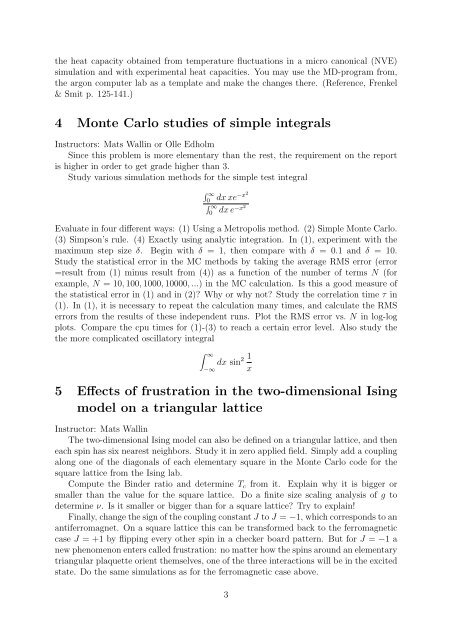
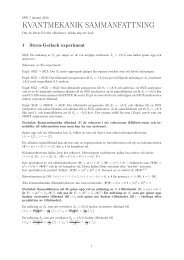

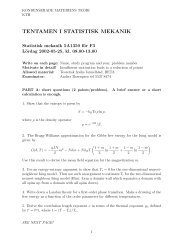
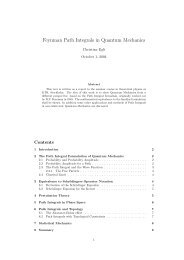
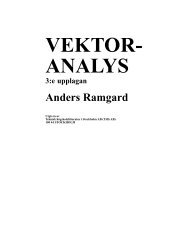
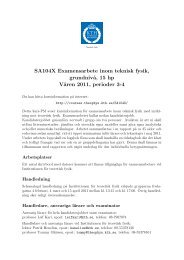

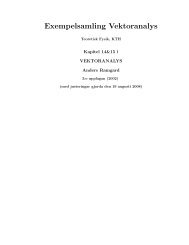

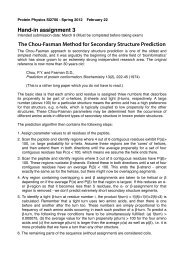

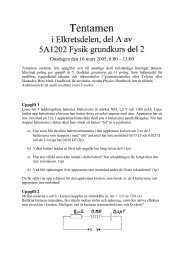
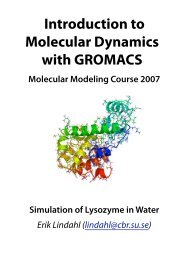
![[VAR]=Notes on variational calculus](https://img.yumpu.com/35639168/1/190x245/varnotes-on-variational-calculus.jpg?quality=85)